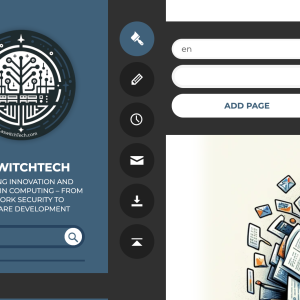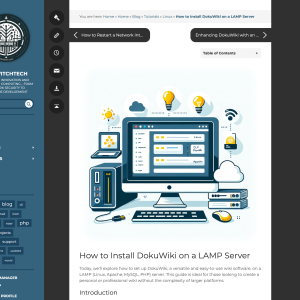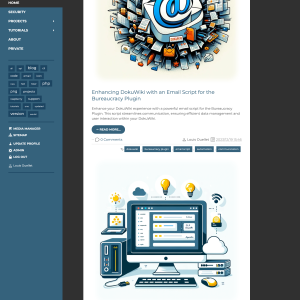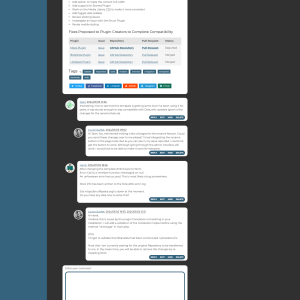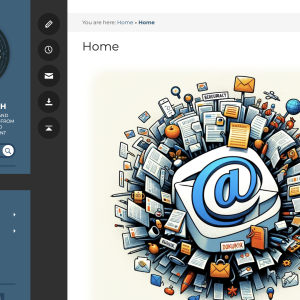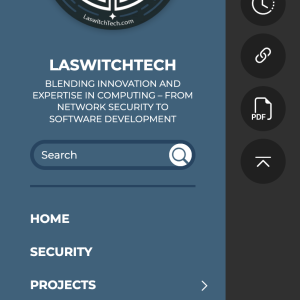Projects

PyRDPConnect (in Development)
PyRDPConnect is a cross-platform Python application designed to provide a sleek, modern, and efficient front-end interface for connecting to Remote Desktop (RDP) sessions. Built with PyQt5, the application supports both macOS and Linux, offering an intuitive and user-friendly experience for users who need to manage RDP connections across multiple environments.
| Author | Louis Ouellet |
|---|---|
| louis@laswitchtech.com | |
| Compatible | macOS, Debian, Raspberry Pi OS |
| Download | Download |
| Bug Tracker | Issues |
| Source | Source |
| Donation | Donation |
Features
- Cross-Platform Compatibility: PyRDPConnect is compatible with both macOS and Linux, with specific adjustments made to ensure seamless operation on both operating systems.
- Customizable Interface: The application uses a customizable UI that allows users to define their preferred settings, such as server address, resolution, multi-monitor support, sound redirection, and more.
- Auto-Detection of FreeRDP Version: The application automatically detects the version of FreeRDP installed on the system and adjusts the command syntax accordingly, ensuring compatibility with both older and newer versions of FreeRDP.
- Bundled FreeRDP: PyRDPConnect includes the ability to package the correct version of FreeRDP within the application, simplifying deployment and reducing dependency issues.
- Certificate Handling: The application handles SSL certificates during connection attempts, providing users with the option to accept or reject untrusted certificates through a dialog box.
- Resource Management: The application efficiently manages resources, including styles, icons, and other assets, ensuring they are bundled correctly in the final application package.
- Connection Management: The interface includes a progress dialog to indicate the status of connection attempts, with options to cancel the attempt if necessary.
- Logging and Debugging: The application includes logging features for easier debugging and tracking of issues during the connection process.
Screenshots
License
This software is distributed under the MIT license.
Third-Party Licenses
This project uses FreeRDP, which is licensed under the Apache License 2.0 license.
Security
Please disclose any vulnerabilities found responsibly – report security issues to the maintainers privately. See SECURITY.md for more information.
Contributing
Contributions to PyRDPConnect are welcome! If you have ideas for new features or have found bugs, please open an issue or submit a pull request.
How to Contribute
- Fork the Repository: Create a fork of the repository on GitHub.
- Create a New Branch: For new features or bug fixes, create a new branch in your fork.
- Submit a Pull Request: Once your changes are ready, submit a pull request to the main repository.
Acknowledgments
- FreeRDP: For providing a powerful and flexible open-source RDP client.
- PyQt5: For making it easy to create a modern and responsive UI in Python.
- PyInstaller: For simplifying the process of packaging Python applications for distribution.
Wait, where is the documentation?
Review the Usage Guide.
To Do List
- Need to add a way to deploy pre-configured
–config-fileinsetup.sh - Need to add support for VPN (openVPN) including a status icon
- Add the ability to customize the plymouth theme with the logo
- Add create a custom openbox theme
- Remove support for FreeRDP Version 2 and Only support FreeRDP Version 3 (Due to lack of support for USB redirections and WebCam redirection), more like support for version 2 only offer limited features
- Install FreeRDP from Repository instead
- Add Profiles, if only one is configured it should be launched by default. A profile should be able to be set a the default profile.
- Move all dialogues into the main dialogues for consistency across multiple OSes
- Update process before stable release ⇒ Execute
git pull - Update process after stable release ⇒ Verify VERSION, Download latest release, unpack, execute
setup.sh - Add 2 installation modes in
setup.sh. Install as an application (default) and install as a thinclient–thinclient. - Add support for DEBUGGING
- Add support for remote apps
Tags
Setup as a Thin-Client
Here is how you can convert a Raspberry Pi or Debian into a thin-client using PyRDPConnect.
curl -s https://raw.githubusercontent.com/LaswitchTech/PyRDPConnect/refs/heads/dev/setup.sh -o setup.sh bash setup.sh

Writr
This template was converted from the WordPress theme Writr. It was voted for by DokuWiki users from a selection of 19 other WordPress themes to convert.
Download and Install
Search and install the template using the Extension Manager. Refer to Template on how to install a template manually.
Features
- Improve the general aesthetic for a more modern look and consistency
- Personalize using template's configurations and template's style configrations
- Support for Bootstrap Icons
- Support for many DokuWiki Plugins (See list below)
- A new toolbar is now available in the template configuration. Based on the original WordPress Theme Writr.
- A new hook
topbaris available to add content to the toolbar. Using the same formatting astopnav.
- A new set of tooltips is now available in the template configuration.
- If toggled, the template will replace the browser's tooltips for these new ones
- Hide/Show Site-Tools based on user login. (CMS mode)
- Set Logo per namespace
- If toggled, the template will look for the nearest logo.png file it can find.
- Set Logo's link per namespace
- If toggled, the template will use the logo's namespace as the link
- Set Site Title per namespace
- If toggled, the template will use the
nstitlehook to retrieve the title of the site. If none can be found then the dokuwiki title is used.
- Set Site Tagline per namespace
- If toggled, the template will use the
nstaglinehook to retrieve the tagline of the site. If none can be found then the dokuwiki tagline is used.
Screenshots
Sites using this template
- AxaMonitor —
No SSL
Documentations
Plugins
| Plugin | Tested | Themed | Comments |
|---|---|---|---|
| Access Counter and Popularity Plugin | Not yet fully supported. Seems like there is a lot to do on this plugin | ||
| ACL Manager | |||
| Add New Page | Styled and added into the page tools | ||
| Advanced DokuWiki | |||
| Plain Auth | |||
| Avatar | |||
| Blockquote | |||
| Blog | |||
| Bloglinks | Read below for more details and customizations of the links | ||
| Bureaucracy | |||
| Captcha | |||
| Cloud | |||
| Comment Syntax support | |||
| Configuration Manager | |||
| Structured Data | |||
| denyactions | |||
| Diagrams | |||
| Discussion | Styled using the WordPress Theme Writr as reference | ||
| DW2pdf | Set a more proper icon within the page tool | ||
| Extension Manager | |||
| folded | |||
| fontawesome | |||
| Gallery | |||
| GH | |||
| Hidepages | |||
| Icons | |||
| Include | Read below for more details and customizations of the links | ||
| Info | |||
| Indexmenu | Styled for the topnav page | ||
| Keyboard | |||
| Linkback | |||
| LogViewer | |||
| Move | Some maintenance is required by the plugin author to fully support PHP8. You may see some PHP Warning if your server is configured to show them. | ||
| nspage | |||
| Pagelist | |||
| Prosemirror | |||
| Revert Manager | |||
| safefnrecode | |||
| Search Form | |||
| Socialite | |||
| sqlite | |||
| styling | |||
| svgEmbed | |||
| Tag | |||
| tagsections | |||
| Translation | Styled and added into the page tools | ||
| Typography | |||
| Upgrade | |||
| User History Manager | |||
| User Manager | |||
| userpagecreate | |||
| Video Sharing Site | |||
| Wrap | |||
| yourip |
Page Tools
| Button | Function |
|---|---|
 | AddNewPage Plugin |
 | Built-in Backlinks |
 | Built-in Back to Top |
 | DW2PDF Plugin |
 | Built-in Edit |
 | Built-in Revisions |
 | Built-in Subscriptions |
 | Translation Plugin |
Configuration
- Show the title of the page tools
- Show the title of the site tools
- Show the title of the user tools
- Should the site tools require login
- Should the logo changes be by namespace
Plugins
Bloglinks
For best results, update your configurations with the following:
- plugin»bloglinks»prev_template =
<span class="icon"></span><span class="title">@Projects@</span> - plugin»bloglinks»next_template =
<span class="title">@Projects@</span><span class="icon"></span>
Additionally, you may add the class truncate to the <span class=“title truncate”> to truncate the page title. This will truncate the title to a single line that fits within the prev and next buttons.
Include
For best results, add the following configuration files:
[WEBROOT]/conf/plugin_lang/include/en/lang.php
<?php /** * * English language file * @license GPL 2 (http://www.gnu.org/licenses/gpl.html) * */ $lang['readmore'] = 'Read more';
[WEBROOT]/conf/plugin_lang/include/fr/lang.php
<?php /** * * French language file * @license GPL 2 (http://www.gnu.org/licenses/gpl.html) * */ $lang['readmore'] = 'Lire la suite';
Customization
Logo
You can change the logo, favicon and apple touch icon the same way as for the dokuwiki template.
Namespace Logo
Namespace Logos can be added using the media library. To show a different logo in a namespace, just make sure to add the custom logo.png in the namespace. This feature is recursive.
Navigation
This templates supports multiple levels of a navigation. For that to work you need to add a page called topnav and add a list of links to it. (No other content is supported.)
The example in the screenshot uses this as the content for the topnav page:
* [[:start|Home]]
* [[wiki:DokuWiki]]
* [[wiki:Syntax]]
* [[:Sample Page]]
~~NOCACHE~~
Other sidebar content
The content of a standard sidebar as configured in Configuration Setting: sidebar will be added between the navigation and the tools list.
Note
I haven't tested a sidebar yet since the last various updates I made. I will check it out soon.
Include hooks
Include hooks allow you to add additional HTML or PHP to the template without modifying any of the template files themselves. This template supports the same include hooks as the dokuwiki template.
Colour Schemes
The original WordPress theme came with 6 different colour schemes. Those can easily be achieved by changing the __theme_color__ and __theme_color_alt__ values in your local style.ini to the following:
| Colour scheme | theme_color | theme_color_alt |
|---|---|---|
| turquois | #1abc9c | #16a085 |
| red | #e74c3c | #c0392b |
| purple | #a162ba | #8e44ad |
| grey | #95a5a6 | #7f8c8d |
| green | #2ecc71 | #27ae60 |
| blue | #3498db | #2980b9 |
This should actually be done in the styling plugin over the admin interface. No need to go out of your way to edit style.ini.
Note
I will be moving this to themes and setup a custom theme so users can set these colors and other css properties not currently supported by the styling plugin.
Content width
The width of the content area can be adjusted with the __content_width__ variable in the style.ini. Since DokuWiki version 2015-08-10 “Detritus” you can do that more easily with the styling plugin over the admin interface.
This is currently limited to px size. Will try to add a full-width option for the template.
Development
Changelog
- Version Upped (2024/10/10 15:20)
- Added a template logo (2024/10/10 15:17)
- Fixed an issue with overlapping tooltips (2024/10/10 15:14)
- Updated the wrap boxes CSS for a more minimalistic look consistant wi… (2024/10/10 15:14)
- MINOR - Code cleanup (2024/03/07 21:30)
- FEATURE - Added a custom color for the user tools area. Available in … (2024/03/07 21:30)
- MINOR - Parsed the nstitle and nstagline to remove newlines and <p> tags (2024/03/07 21:21)
- MINOR - Removed duplicated attributes (2024/03/07 21:17)
- MINOR - Update the title on the logo according to the template settin… (2024/03/07 21:14)
- FEATURE - Added support for namespace site title and tagline using ho… (2024/03/07 20:50)
- MAJOR - Fixed the replacement of logo.png with the start page using t… (2024/03/07 19:10)
- Added support for namespace logo links (2024/03/07 19:05)
- Minor - Version Upped (2024/03/07 18:44)
- Added custom CSS for JQuery-UI (2024/03/07 18:43)
- Added screenshots of the new sidebar users tools (2024/03/07 17:41)
- Moved page-tools outside of the widget in order to base the border of… (2024/02/27 20:14)
- Made the editor's toolbar take an entire row (2024/02/27 13:27)
- Added a space between the icon and the label of the button (2024/02/27 13:27)
- Fixed an issue when the avatar default size would be changed by setti… (2024/02/27 01:37)
- MINOR - Fixed email icon in toolbar (2024/02/26 20:26)
Planning
- Add more fonts (suggestions?)
- Add option to make the content full width
- Add support for Starred Plugin
- Work on the Media Library CSS to make it more consistent
- Add toggle-able sidebar
- Review existing issues
- Investigate an issue with the Struct Plugin
- Revise mobile styling
- Revise responsive styling
Tags

Enhancing DokuWiki with an Email Script for the Bureaucracy Plugin
Enhance your DokuWiki experience with a powerful email script for the Bureaucracy Plugin. This script streamlines communication, ensuring efficient data management and user interaction within your DokuWiki.










